The Future of Voice and Chatbots in the Workplace with Chad Oda
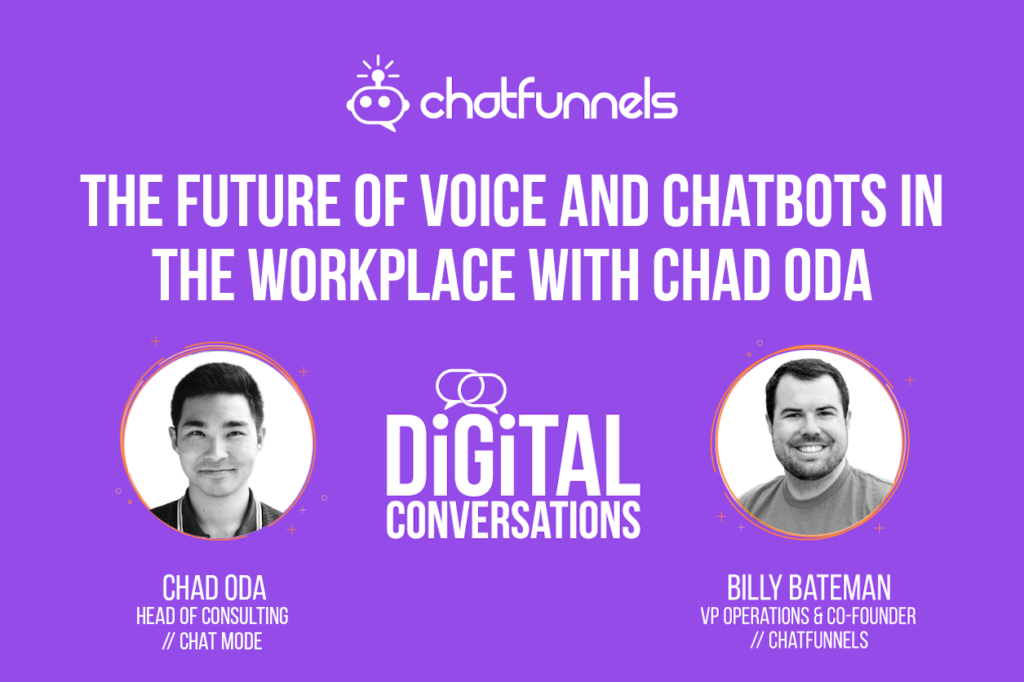
Reading Time: 16 minutes
Overview: This week on Digital Conversations with Billy Bateman our guest is Chad Oda senior consultant at Chat Mode and host of The Bot Podcast. He discusses integrating chatbots and voice into the business space and the future of chatbots.
Guest: Chad Oda– Chad possesses a comprehensive understanding of conversational interfaces (e.g. Alexa, Chatbots, etc.) and how brands can pragmatically leverage this paradigm-shifting technology to engage customers with innovative, intuitive, and personalized experiences. Chad has extensive insight & expertise into the design, development, and implementation of these immersive conversational interfaces. From conversational copywriting to natural language processing, and multi-modality, Chad has his pulse on the ever-evolving conversational ecosystem.
Chad has collaborated with the top technology companies such as Oracle, Microsoft, Amazon, LivePerson, and Google. Chad also speaks internationally at the leading conversational conferences. Check out the Chat Mode website!
Listening Platforms:
Transcript
Billy: Alright everyone, welcome to digital conversations. This week I have the pleasure of being joined by Chad Oda, head of consulting a Chat mode. Chad thanks for joining us.
Chad: Thanks for having me. It’s a pleasure.
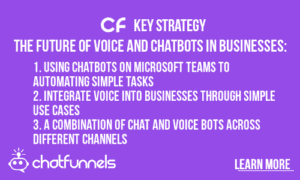
Billy: Yeah, man I’m excited for this. You have your own podcast as well which I’ve listened to really interesting good stuff. I’d encourage anyone to go and check it out. But tell us a little bit about yourself. How you got into this space and then what you guys do a Chat Mode.
Chad’s Background
Chad: Yeah no absolutely. I think like most people I sort of stumbled into this space not exactly knowing what conversational AI was. This was probably back in 2016. I think that was really when we were sitting sort of the peak of the hype inflection point. Facebook Messenger came out with their architecture back at F8. IBM Watson was sort of all the rage. That’s when we initially jumped in on a whim. We had read an article on TechCrunch sort of evangelizing the mysterious power surrounding conversational AI and chat bots. And we bought into it. 100% we dove in.
One of our initial implementations is actually with a healthcare insurance company and that was really our initial salvos into the space. Ever since then we’ve done a lot of really interesting projects from building chatbots for people that are running for election senators to working with Softbank robotics with their pepper bot to working with some of the largest enterprise cosmetic companies like Ulta cosmetics. So, we’ve really sort of seen the spectrum of what chat bots can do and whether actually creating value.
We’ve sort of seen that track and since then it led us to really focusing within the Microsoft ecosystem specifically deploying conversational AI for teems, on Microsoft teams. That’s the internal business facing messaging platform not too dissimilar from slack. Now the reason why we’re very bullish on chatbots on Microsoft teams is because pretty much any company, small business to large businesses, is focused on customer experience as a major initiative right. And companies have seen significant value add as a result of that. I think the pinnacle of customer experience is really for the customer to feel like they have superpowers. I think the best example of that might be if you could remember back to the first time you use Uber. It’s like wow I can order a car and like stand here and it knows my location and it accesses my digital wallet.

I think the interesting nuance for us is companies have spent so much time and money and effort for customer experience but have not spent too much time applying those same principles internally inside of organizations. If you think about employee experience, for any other listeners that have ever worked in the corporate world, just trying to put your expenses for a trip is mind numbingly difficult. Navigating through multiple portals and accessing reports. So, for us if we can use a chatbot to abstract the complexity of 20 steps and make that one step inside of Microsoft Teams we really see a lot of value in doing that.
Billy: I can see the value as well. We use teams here and when we made the transition. We started out with slack and then we already paying for teams and the team got big enough we’re going to have to start paying for slack. We’re just going to use teams. We already pay for this and it’s great. But the complaint from my developers was like there’s all these little like bot plugins for slack. We don’t have those for teams. So, walk us through what are some use cases that you guys are implementing for your customers that they’re using on teams?
Microsoft Teams and Chatbots
Chad: Yeah no absolutely. To your first point as well Microsoft I think they came out with teams back in 2017. So, there’s been several years. Originally, they tried to make this push for bots on the platform but I think there was sort of a slow roll. When you look at the adoption of teams relative to the actual adoption of the Office 365 ecosystem. It was sort of a small number in the early days. But there’s always been a possibility to integrate bots with Microsoft Teams but today provided the really high adoption. I think it’s 70 million monthly active users we’re now seeing sort of like renewed energy and interest into not only Microsoft providing the architecture and the awareness to do it but also slowly the community rallying around actually building really good bots for this specific platform here.
Use Case #1
Then specific to your question around use cases. I mean the primary three use cases we’re seeing internally within organizations is number one, notifications. If we can think about you know the line of business manager that has to pull a report. Let’s say using Microsoft marketing for assessing how many marketing qualified leads are hitting their inbound every single day. They have to go through four or five steps. If they get a notification and teams boom easy for them. Saves up a bunch of time.
Use Case #2
Secondly what we’re seeing is a lot of knowledge management use cases. No matter what sort of vertical you are in knowledge management is always been this very painful numbing experience. And we’re seeing quite a lot of traction in that area. Where companies are essentially coming to us and saying, hey we have this knowledge repository. Maybe it’s on SharePoint. Maybe it’s in some other platform. And we’re having difficulty accessing it. So essentially, we’re building these bots that can essentially parse through that information and make it really readily available for them to access quite quickly.
Use Case #3
Another third use case we’re seeing is if we can sort of use chat bots to trigger or build out business process automation that’s like a no brainer for companies. Now we’re getting to that level. We’re creating this repeatable value that can be accessed. Whether that’s pulling a report or pushing data into a CRM system or pulling data out of our CRM system. Now that becomes very valuable. Then I think the extension to business process automation enabled by chat bots now allows additional value can be created on top of the initial transaction or a task driven conversation.
So, what we’re beginning to see is the emergence of something called conversational intelligence. For example, let’s say that there’s a chat bot that we’ve created to input opportunities to Microsoft Dynamics. I’m a sales Rep, I want to enter something into Microsoft Dynamics, I use the chatbot, boom, I could do.
Now there’s a secondary layer we could add on top of there, where we can extract additional value from that. So essentially let’s say they add in Coca-Cola and they have some sort of like business rep that they think is an opportunity for them. There’s the opportunity they entered in the system. What we can actually do is add robotic process automation on top of that. Once that is actually inputted into CRM, we can use RPA to essentially do a look up of that person and essentially pull additional information from the Internet or from a database they have access to. And in put that into the CRM system. So quite a lot of interesting use cases that are possible within specifically the Microsoft ecosystem.
Billy: So is it similar to a many chat? Where you can do like a drag and drop builder, or do you need to be technical developer to set one of these up?
Using Existing Connections
Chad: Yeah no it’s a really great question. I think Microsoft has finally gotten to the stage where I can say that their ecosystem for conversational AI is at this mature enough stage where at the base level, at the underlying foundation, everything is built around this framework called bot framework. If you’re a developer, you can get in there you can use the framework. You could build things from scratch. Now they’ve essentially abstracted the complexity into really 2 software offerings. The first one is called composer. Composer, if you sort of imagine Google dialogue flow.
It has those two components. We can get in there if we’re non developer access the different dialogues, developed design. And similarly, if you’re a developer you can also extend that through integrations and things of that nature. Now Microsoft is also taking it to an even higher level of abstraction by introducing Microsoft power virtual agents. Which effectively to your point is the Many Chat is the Chat Fuel type of GY functionality that a lot of us non-developers are familiar with. And you could go in there build bots, easily deploy them onto Microsoft Teams. Now the interesting thing that makes this so powerful is the fact that there are existing connectors that already exist within the Microsoft ecosystem.

So, I can easily plug in data sources from dynamics, from SharePoint, from power BI from all of these value-added solutions. I think maybe the parallel to the Many Chat, Chat Fuel ecosystem is using something like using any of the additional connect API connectors that exist to pull that data maybe into HubSpot or something like that.
Billy: Awesome man. Where do you think this is going? We use teams all day. I mean we’re a small company we’ve got about 12 people but we’re in it all day. Especially now we had about a month where we were remote until in Utah, they said your small group you can come back and start working together again. Where you see it going? Are you seeing more companies adopting using these bots on their teams to help information flow?
The Future of Employee Experience
Chad: Yeah absolutely. So, the way that we sort of see is unfortunately the employee experience bar has been set very low right. It’s not often times that you walk around the office and you ask your employee do you feel like you have super powers when you do your job? And it’s very rare but sometimes maybe there’s some automations like Microsoft Teams or slack that makes their job much easier and much more accessible and enables collaboration. So, if that’s like sort of the base level, the status quo. I think we can look at many organizations and that tends to be the case. We can begin to like to build up incremental value through notifications, through Q & A bots, through more dialogue task driven bots.
So I think this trend is going to continue within organizations that are going to enable any employee to really be able to do their job much more efficiently and effectively. Then for organizations to sort of leverage that as sort of a significant differentiator when it comes to competition. I mean you want to be the organization where your employees are spending 90% of the time on sort of like higher order more complex problems versus the mundane things that they have to do that are really time consuming. So, I certainly think this is going to be the continued trend.
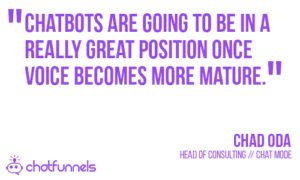
What I would say, within the spectrum of conversational AI. I would certainly say that organizations today that begin to implement sort of line of business or business process automation that surface with chatbots are going to be in a really great position once voice becomes more mature.
I think voice from a consumer standpoint is pretty ubiquitous. We have Alexa, we have Google Assistant, Siri to a lesser degree. But we haven’t really seen, from a business standpoint internal facing for businesses, voice play a very dominant role yet. What we see with Microsoft, is Microsoft is really wholly going to try and corner that market.
Voice and Chat Working Together
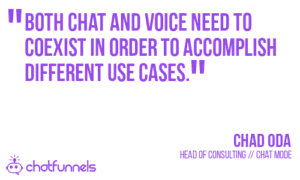
If we look at teams, my head of operations actually I think he had a good metaphor for teams. He said teams is the operating system for organizations. Now for operating systems to become really valuable you need applications inside of that. Now what we see with sort of voice is, voice is that next frontier. Both chat and voice need to coexist in order to accomplish different use cases. Because there’s pros and cons using voice over chat. I think once voice actually really comes to market for businesses, I think we’re going to see a lot of increased productivity that we just have never seen before. That’s sort of the road map we see today.
Insert really value driven, simple use cases that drive value today with chat bots. Then utilize that in addition to aggregating conversational data to figure out okay here’s what the chatbot can do. Here’s what additional conversational data where employees are asking for other stuff, let’s use that to inform our additional use cases we end up developing. And then by the time Microsoft reintroduces Cortana which they’ve since deprecated. Once they reintroduce that those organizations are going to be in this very strategic position.
Billy: That’s very interesting. If you can get voice into teams. And you’re right it is becoming like the operating system. We run on it, I know my wife’s company, where she works, they’re all about teams. And a lot of our customers as well, they’ll add us to a team’s channel so that we can communicate with them very quickly and efficiently. Where do you see voice going now that we’re talking about this because you’re right, on the consumer end like it’s getting there. It’s becoming more popular. A lot of people having Alexa or Google home and they’re using it quite a bit for business though. What needs to happen for that adoption really to start happening?
Voice in the Workplace
Chad: Yeah no absolutely. I think voice is interesting because I think for whenever you got into chatbots. I mean I think there’s always been this prevailing hype around it, and I think for the last couple of years it seems to have died down. Which is why you know businesses like yours and mine can sort of exist today. Because you know stakeholders at these organizations see, okay well just little more refined use cases that are creating definite value today. Now with voice, voice sort of seems to be at that inflection point of hype. Where we saw chatbots in 2016. For really simple use cases like single turn interactions where I say play music or tell me what the weather or things like that. It seems like there’s pretty high adoption.
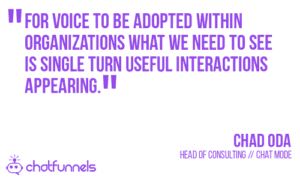
For voice to be adopted within organizations what we need to see is those same sort of single turn useful interactions appearing. Then also for the incumbent technology companies to begin surfacing voice in a meaningful way. So, when we look at Google and Amazon, they’re almost wholly focused right now on the consumer facing side of things. Have not really seen a lot of, although Bixby from Samsung,
I know they’ve been trying to play a little bit inside the line of business ecosystem. But I think once Microsoft comes out and really introduces this concept of ask Cortana for the monthly quota report for the sales team. That’s something easy, it’s not multiple steps. It’s one thing. Accomplishes one task. I think it’s a function of both the technology companies is surfacing the technology so it’s readily available. Also similarly identifying those use cases that are not overly complex. Are simple and create value.
Billy: I think that makes sense. Voice is not something I know, we’re mainly in the chat bot space. So, you go to a conference there’s always a couple panels on voice. It’s interesting but you’re right, like we had an Alexa for a while at my house and we use it to set a timer, play some music, play a podcast, tell me what the weather is like. Just do this one thing. And it would make sense with business that is the way we’re going to get some adoption is okay, tell me what’s on my schedule today, tell me what the sales reports going to be or where we are against quota. Very simple things but that’s probably the way to get some adoption.
So what do you see the challenges just in the overall like chat bot voice ecosystem? Where are the challenges that you’re seeing that we need to overcome?
Challenges in Voice
Chad: Yeah I think that’s a great question. I think challenges are a good thing. I think if there’s no challenges that exists in the market is pretty much tapped out. But I think we’re right at that precipice today, where we’ve solved enough challenges to get to this point here. That’s not to say there aren’t challenges. So, a couple off the top of my head. Number one I think there has to be some more standardization around conversation design. I feel as though that is this very nebulous buzzword that means a lot of different things to a lot of different people. As far as the frameworks and methodologies that exist today, that I’m aware of, there are not any that are very comprehensive.
So, I think in order to ensure that we’re creating business value every single time there has to be some standardization within the community. To say, hey this is the process for conversation design. It’s very customer centric and here’s how we can really create the most value anytime we started building on these technologies. So that’s one of the first things I would say but it seems like the overall community is trending.
Billy: I think we’re getting there. We talked to a lot of different people that are building at least chatbots and we’re getting to where everyone realizes, okay when you build a bot you can’t build a bot to be all things to all people. Here is the one goal, make it very clear what this bot can do for you. Now what happens in between, we’re still working that out I think as an industry. but I think you’re right. We’re trending towards some standardization in the conversational design and how that goes forward.
Chad: Yeah and absolutely. Another challenge I see that specific to market adoption. It’s interesting because what we tend to see is on the enterprise side, they tend to adopt. Or fortune 500 tends to adopt these emerging technologies a bit faster because they have the money. They have the money to burn. Millions of dollars are going into conversational AI initiatives from banking to insurance to health care, it’s all there. And they can spend the money and have dedicated teams and their leveraging things that are off the shelf they’re building things in house.
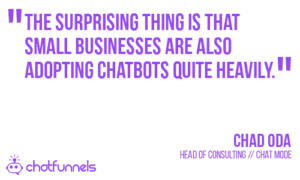
And generally, their pioneering some directions with conversational AI but the surprising thing is too that when we look at small businesses there actually also adopting Messenger based chatbots WhatsApp based chatbots even SMS quite heavily.
Billy: Most of our customers are using something like a Drift or an Intercom or our platform to engage on their website. We go anywhere from startups to large not large enterprise but large SMB.
Trends in the Adoption of Chat
Chad: Absolutely yeah, it’s quite phenomenal to see that adoption on both sides. The interesting thing is when we look at the mid-market space, they actually have the lowest percentage of adoptions. When I started to think about that a little bit it’s almost like the majority of platforms that exist, or offerings are very much catered towards the enterprise space.
They have these platforms that are now emerging to the extent that you have some division of labor where their deep coupling, this is the design part, this is the CMS part, and this is the development and sort of integration components to these things. That doesn’t really seem a very palatable model even with the pricing for mid-market. Because mid-market it’s a shared services model. They don’t have dedicated people to build these bots out. So that’s like a challenge that we really sort of see in the ecosystem.
Where we sit is that we see for companies in mid-market space that already adopted Microsoft ecosystem. They probably use dynamics or share point or something like that. And with teams and the ecosystem that Microsoft is developing around it it’s going to be very accessible for mid-market companies now to deploy chatbots in a way that is much more financially viable for them. And also, much more solution focused. So that’s certainly an area I think we’re going to continue to see a lot of opportunity and perhaps different players emerge specifically targeting the mid-market space.
Voice and Chatbots working Together
Billy: That make sense. Good points Chad. So we got to wrap it up here but is there anything I should have asked you? If you’re like if Billy was really smart, he would have asked me about this that I haven’t?
Chad That’s a tough one. Oh man I thoroughly enjoyed this conversation. I think we really hit on a lot of really interesting points. Just trying to think. Something I do like to talk about quite a bit actually is where does all this technology lead us to? We see chatbots we see voice today. What I sort of see is number one there tends to be like this myopia that develops anytime there’s new technologies. Where we’re trying to force all the value out of these individual technologies. I think what’s sort of occurring today is we’re going to begin to see this decoupling from any one solution or any one device. I think we’re trending towards, if you read the press releases coming out of Google, they started using this term called ambient computing. What does that even mean necessarily?
Billy: Don’t even ask.
The future of bots
Chad: Exactly so I think what their tracking towards this notion is where the future is going to bring us to a point where the interfaces are entirely decoupled from the back-end experience. I think there is a way for us to begin to start to think about how we build these solutions. In the sense that we’re not just delivering point solutions. So, in the future it’s not just going to be chatbots, singularly for one experience or just voice, singularly for one experience. It’s going to be the combination of both perhaps at the same time.

So, for us in the conversational AI space to start at least thinking about that and you know talking to other people on both sides of the fence. Whether it be voice or chat, I think will very much prepare us for when these big shifts begin to happen. I’m very convinced that Google, once they actually deploy what they’re going for. And what I think is if you see that Google Assistant has been rebranded under Google Home. Google home has been their entire IOT initiative to essentially bridge all those Internet connected devices and drive immediate value for the end consumer in a way that’s unprecedented to a certain extent.
But I think if you take just the digitalization of the home with IOT and all those connected interfaces and then you begin to look at what Google has developed already ready for the last like 20 years we began to see as Google pretty much owning anytime you want to book an appointment with really anyone. A haircut, a plumber, Google has that knowledge graph and they can already surface that. I think the interesting thing is once they integrate Nuplex that’s going to be totally wholly end to end, it will schedule you the entire thing. So, if we can start to look at it within that sort of slice, maybe that’s five years away, maybe that’s ten years away. But just sort of thinking about that.
Billy: Yeah no I think I think you’re right. It’s not going to be if I’m a business and I have my Facebook chatbots I have my chatbots that I run an Intercom on my website and then maybe I have some type of voice or SMS bot. Those all, right now they all live in different silos. Bring them all together really is the future.
Chad Absolutely.
Billy: Well I appreciate it Chad. If people want to get ahold of you and continue the conversation, where can they find you?
Chad: Definitely, feel free to look me up add me on LinkedIn Chad Oda and check out our website at Chat Mode.IO.
Billy: Okay man thanks and we’ll chat later.
Chad: Cool thanks so much Billy.
